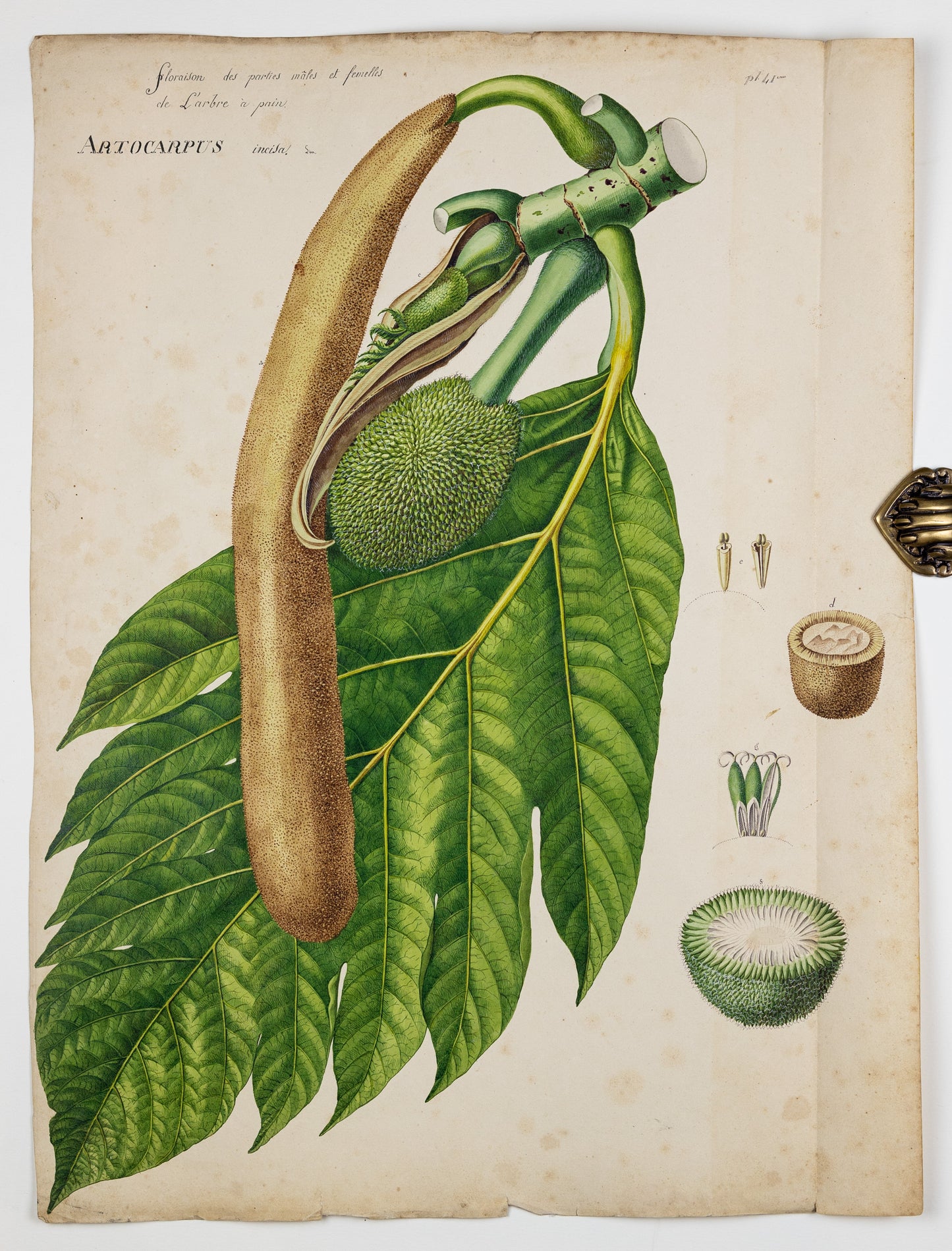from: Poiteau & Turpin Superb Botanical Drawings including varieties from the West Indies
PIERRE JEAN FRANÇOIS TURPIN (FRENCH, 1775–1840). A male catkin of a Breadfruit Tree. 1808–1827.
PIERRE JEAN FRANÇOIS TURPIN (FRENCH, 1775–1840). A male catkin of a Breadfruit Tree. 1808–1827.
Couldn't load pickup availability
PIERRE JEAN FRANÇOIS TURPIN (FRENCH, 1775–1840)
“Artocarpus incisa” [A male catkin of a Breadfruit Tree]
Preparatory drawing for F.R. Tussac, Flore des Antilles, ou histoire générale botanique, rurale et economique des végétaux indigènes des Antilles.
Paris: chez l’auteur, F. Schoell et Hautel, 1808–1827. Vol. 2, Plate 4
Watercolor and pencil on paper
Frame size: 26 1/2 x 21 1/2 in.
“The male and female flowers are both arranged on catkins, not far apart from each other; they are usually enclosed in a spathe, which opens into two valves; but in the species that I describe, the male catkin comes out of the top of the branches, and is enclosed in the same spathe or scale which envelops the young leaves or the terminal bud; this catkin, which at the time of its appearance was not more than two inches in length, becomes a fleshy, cylindrical body, a little compressed, seven or eight inches in length, by an inch and a half in diameter, on which the male flowers are so pressed against each other, that one sees, with the naked eye, only yellow asperities, and that it is only with the aid of a magnifying glass, and by dissection, that one can recognize their organization. They are composed of a tubular, trigonal calyx, truncated at its summit. It has no corolla, there is only one stamen, whose filament, a little longer than the calyx, bears a bilocular oval anther...
The botanical description that I have just given of the genus Jackfruit, differs in some points from those which have been made by different authors; but the anatomical details of the flowers and fruits of this important plant having been observed and drawn, from nature, by Mr. Turpin, as learned a botanist as an exact draughtsman; having myself made continued observations on this tree that I cultivated on my home in Saint-Domingue, I believe myself justified in assuring the public that this new description is the most accurate that has yet appeared...
This tree, so interesting, was brought from the islands of the South Sea, to Jamaica, by Captain Bligh, English... They are nestled in a white pulp, in the interior of the fruit of this jackfruit, to the number of forty to sixty, according to the size of the fruit, which is usually that of a child’s head; each seed is enveloped in a fleshy tunic which, in this species, is not eaten. This tree is today has multiplied in all the Antilles, and should be even more… It is necessary to observe, if one wants to make a considerable plantation of jackfruits, to place it in the places most sheltered from strong winds, especially from the North.
Perhaps there would be another way to multiply the Jackfruit, which would be to graft it on congeners, or at least on trees of the same natural family… for a greater probability of success, it would be necessary to graft the Apirene Jackfruit onto the seeded Jackfruit…
As a naturalist and observer, I have acquired several, in order to be able to judge of the degree of importance that these so renowned fruits deserve. After having exhausted all the ways of preparing them, to better know their flavor, the one that seemed to me preferable and the most expeditious, is to cook them whole in the oven. They are then cut into slices, which are eaten as bread with meat or other foods; the pulp is very white, more succulent than floury; its taste has some relation to that of our Jerusalem artichokes (helianthus tuberosus); but it is less firm, and much easier to digest…
Another way of eating this fruit, more agreeable to my taste, is to cut it transversely into slices about three lines thick, to toast them like toasted bread, and to put a little fresh butter on top…
We also make stuffings with the pulp of the jackfruit, mixed with coconut scrapings, rice, onion and various groceries, to put inside poultry that we roast. I ate a guinea fowl prepared in this way, which I found to be very tasty, and even better than those that we roast without stuffing…”

Appeared in F.R. Tussac, Flore des Antilles, ou histoire générale botanique, rurale et economique des végétaux indigènes des Antilles.
Paris: chez l’auteur, F. Schoell et Hautel, 1808–1827 — a partial study for Vol. 2, Plate 4.


